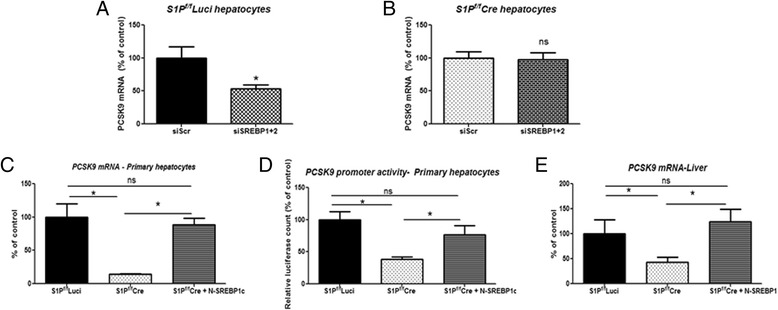Fig. 6.

A molecular mechanism for regulation of PCSK9 by hepatic S1P. a and b, Primary hepatocytes (S1Pf/f Luci or S1Pf/fCre) were transfected with non-targeting control siRNA (siScr) or SREBP1 + 2 siRNA (siSREBP1 + 2) and cells were harvested 56 h post transfection for RNA isolation. PCSK9 mRNA quantification after combined KD of SREBP1 and SREBP2 in S1Pf/f Luci hepatocytes (a), and S1Pf/fCre hepatocytes (b). N = 3, each data point represents a mean +/- SD, * denotes p < 0.05, ns denotes non significant. All values plotted as % of siScr control; (c and d), PCSK9 mRNA levels (c) and PCSK9 promoter activity (d) were measured in S1Pf/f Luci and S1Pf/fCre hepatocytes after transduction with either Ad-Luci or Ad N-SREBP1c. N = 3, each data point represents a mean +/- SD, * denotes p < 0.05, ns denotes non significant. All values plotted as % of S1Pf/f Luci control; (e) Hepatic PCSK9 mRNA levels were measured in three groups of mice: i) S1Pf/f Luci (transduced with 10 viral particles of Ad-Luci per mouse); ii) S1Pf/f Cre (transduced with 5×1010 viral particles of Ad-Cre and 5×1010 viral particles of Ad-Luci per mouse); iii) S1Pf/fCre + N-SREBP1c (transduced with 5×1010 viral particles of Ad-Cre and 5×1010 viral particles of Ad-N-SREBP1c per mouse). Mice were fed ad libitum. N = 3–4, each data point represents a mean +/- SD, * denotes p < 0.05, ns denotes not significant. All values plotted as % of S1Pf/f Luci control
